Author Archives: pmalder
HEALTH ADVISORY: Disinfectants Sold and Stored in Drinking Water Bottles and Other Inappropriate Containers
The following health advisory was released by The Texas Department of State Health Services (DSHS):
Background:
The Texas Department of State Health Services (DSHS) is reminding the public only to use disinfectant and pesticide products that are in properly labeled containers from the product’s manufacturer.
As reported to the Texas Poison Center Network, a pesticide control company in Texas has repurposed plastic drinking water bottles to sell a product used for COVID-19 disinfection. In one case, a person took a drink from a clear labeled plastic water bottle found in the refrigerator at work, then noticed the taste and found a small label saying “Virucide” stuck over the water label. In another situation, a child accidentally consumed the chemical by drinking from a water bottle. Although both cases ended up in the emergency department, there were no adverse health outcomes.
The product, Nisus DSV virucide, is a broad-spectrum disinfectant, sanitizer and virucide that can kill many different types of bacteria and viruses. EPA has determined Nisus DSV to be effective for use against the novel coronavirus, SARS-CoV-2, which is the cause of COVID-19 (https://cfpub.epa.gov/giwiz/disinfectants/index.cfm). When used correctly in accordance with the instructions on the label, disinfectant products are safe and effective. However, improper use can have harmful health effects.
Clinical Presentation:
Nisus DSV is highly corrosive with a pH of 12 and should not be consumed. The risk of harmful effects depends on the route and amount of exposure. Brief exposure may cause eye irritation and drying of skin. Longer exposures may lead to burns and blindness or other permanent eye injuries. Ingestion and inhalation of vapor from the product can irritate the throat and respiratory tract. Ingestion of high concentrations may lead to central nervous system effects and symptoms include headaches, dizziness, and drowsiness.
Recommendations for Public:
To reduce improper use and prevent unnecessary chemical exposures, users should:
- Seek immediate medical attention if you have swallowed Nisus DSV or any other disinfectant chemical or are experiencing symptoms from use of this product and contact your poison center at 1-800-222-1222.
- Always read and understand directions completely on the product label before application.
- Only use disinfectant or pesticide products that are in properly labeled containers from the manufacturer.
- Store disinfectants and cleaning products in a location out of the reach and out of sight of children. Do not store chemicals where food is stored.
- Do not mix disinfectants with soaps and detergents.
Guidance for cleaning and disinfecting public spaces, workplaces, businesses, schools and homes may be found at the Centers for Disease Control and Prevention (https://www.epa.gov/newsreleases/epa-cdc-release-guidance-cleaning-and-disinfecting-spaces-where-americans-live-work-and).
For More Information:
Anyone who believes they may have been exposed to disinfectant products and are concerned about their health should contact their healthcare provider or the Texas Poison Center Network at 1-800-222-1222.
DSHS Environmental Surveillance and Toxicology Branch
512-776-7268
epitox@dshs.texas.gov
Featured Insect: The Bat Bug
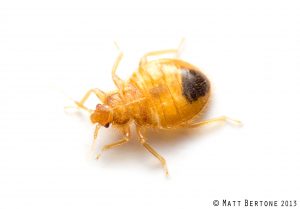
Bat Bug Nymph
As their common name implies, the primary host of bat bugs (Cimex adjunctus) is bats. Occasionally, however, they will feed on humans if their preferred host is not available. As with the human bed bug (Cimex lectularius), bat bugs have not been shown to transmit any disease-causing pathogens to humans. However, bites from both bed bugs and bat bugs can cause insomnia, anxiety and stress to many individuals.
Bat bugs are often confused with bed bugs. Thus, it is important to be familiar with the identification, biology and management of these bugs. Since bat bugs treatments differ from treatments for bed bugs, correct identification is critical for success.
Bat bugs and bed bugs look nearly identical to the naked eye. A stereoscope or USB digital microscope with magnification between 20x and 50x is needed to distinguish between the two species. One distinguishing feature is that the fringe hairs on the pronotum (the area directly behind the head) of the bat bug are as long or longer than the width of the eye, but are shorter in the bed bug. In addition, the front edge of the pronotum of the bat bug is slightly concave, while the bed bug’s pronotum will be more deeply concave (see photo below).
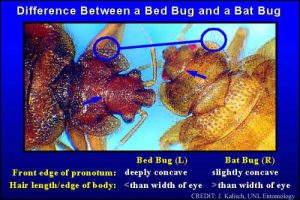
Bed bugs and bat bugs have different habits. As mentioned previously, the primary hosts of bat bugs are a variety of bat species, many of which roost in colonies. However, in the absence of bats, bat bugs can feed on other warm-blooded animals, including humans. Bat bugs are often encountered inside a structure when bats are established indoors – usually in attics, wall voids, unused chimneys, or other similar places. Typically, bat bugs are found in cracks and crevices wherever the bats are roosting. However, if the primary hosts (bats) leave the nesting area, die or are removed/excluded, bat bugs begin moving inside a structure within one to four weeks to feed on alternative hosts. Once they are set up in living spaces and have found a host on which to live, bat bugs will become established the same way as bed bugs. They will hide in mattresses and box springs, bed frames and other places where the host spends most of its time at night.
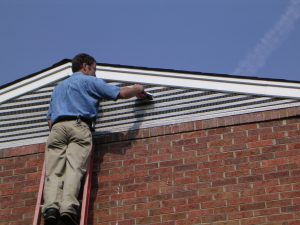
Bat exclusion (Photo: Mike Waldvogel, NCSU).
To eliminate bat bugs, bats must first be excluded or removed from the building (see photo at right). Once bats are excluded or removed, thorough crack-and-crevice and spot treatments of residual insecticides to all bat roosting areas are necessary. Dust formulations work very well against both bat and bed bugs and can be helpful in places where drift to non-target areas is not an issue. Pay particular attention to areas around objects leading indoors, such as light fixtures, vents, plumbing chases and chimneys. These treatments are critical to kill bat bugs that will begin moving to living places after losing their host.
If you see what appears to be bed bugs crawling down a chimney or from an attic, or in another atypical location for bed bugs, identify and confirm the species as quickly as possible. Once you have a positive ID, treatment should be scheduled as soon as possible because as with bed bugs, a moderate infestation can develop in a short amount of time. Finally, make sure to your customer is aware of what the treatment will entail and how long it may take to eliminate all the bat bugs. It is not unusual to see bat bugs showing up in living places for several weeks after treatment before they are gone for good.
Ant Invasion
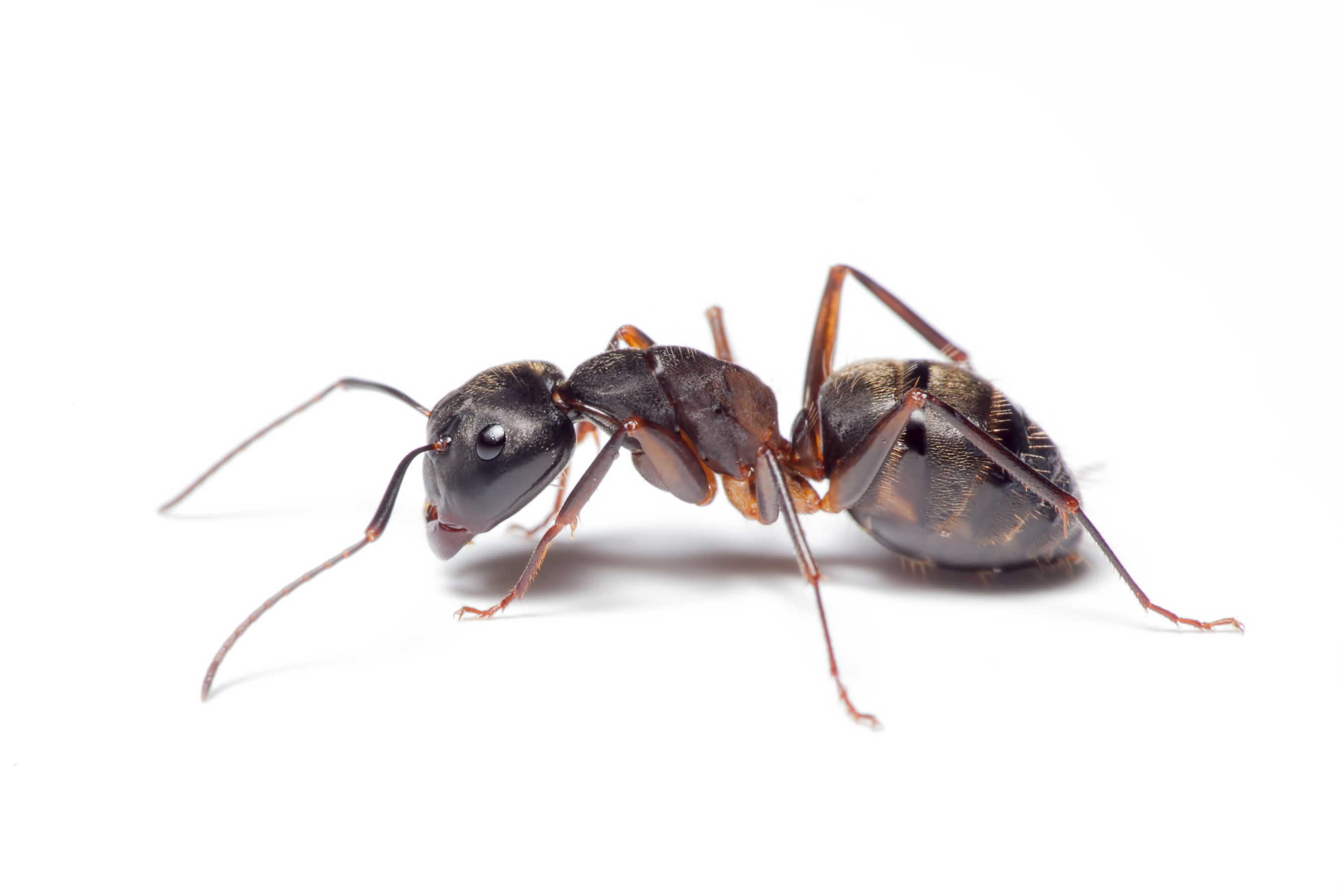
Carpenter Ant Worker (Photo: Patty Alder)
Ant season is upon us, and it’s likely you are up to your ears in calls from customers seeking some relief from ant invasion.
Know your enemy. The first order of business for successful ant management is knowing what ant species you’re dealing with. If you are having trouble identifying the species present, refer to this fact sheet: https://content.ces.ncsu.edu/a-guide-to-house-invading-ants-and-their-control. You may also submit insect specimens to NCSU’s Plant Disease and Insect Clinic (https://projects.ncsu.edu/cals/plantpath/extension/clinic/). There is a $30 fee to submit a sample.
Control. Ants invade homes and other structures in search of food, water, and shelter. Therefore, effective ant management needs to be a combination of control methods that involve inspection, sanitation and exclusion, habitat modification, and often some type of insecticide.
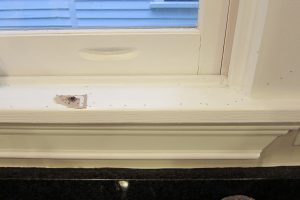
Figure 1. Place nontoxic food bait inside to establish ant trails (Photo: Patty Alder, NCSU).
Inspection. It is important to check carefully and thoroughly both indoors and outside todetermine areas of ant activity, nest locations, and type of ant present. Indoors, follow ant trails to locate their entry point(s). You may consider placing a nontoxic food bait in these areas to establish a trail that you can follow (Figure 1.) Although this will take extra time, it may pay off in those situations where your control efforts have not been effective so far.
Outside, check the foundation, walkways, trees and shrubs, and in mulched areas for ant trails. Look for nests in mulch and vegetation next to the foundation. Check under potted plants, patio blocks, and stepping stones, and in piles of rocks, lumber, and firewood. Inspect the foundation to find possible ant entryways such as areas where pipes enter the building, foundation cracks, and around doors and windows. A careful inspection of the attic and crawl space may be necessary as well.
Sanitation and Exclusion. Removing or reducing indoor sources of food and water can help reduce ant activity indoors. Susceptible food items should be stored in pest-proof containers or stored in the refrigerator. If possible, pet food should not be left out continuously. Wiping down indoor surfaces, such as floors and countertops, with soapy water is helpful in a couple of ways. First, the soap removes food residue that may be attracting the ants. Secondly, it disrupts the ant pheromone trails that are leading more ants indoors. Don’t forget to check for leaks or plumbing issues that could be drawing ants indoors.
Exclude ants from entering the structure by recommending any gaps, cracks, or holes around windows, doors, and foundations be sealed up.
Habitat Modification. Habitat modification involves landscaping and other activities that can reduce the likelihood of ants nesting in areas around homes. For example, mulch often provides an excellent nesting habitat for many ants. It provides shelter, warmth, moisture and it can prevent pesticide sprays from reaching their intended target.
Mulch, leaf litter, and vegetation should be kept 10-12 inches away from the house foundation. Piles of lumber, firewood, bricks, and stones should be stored away from the house.
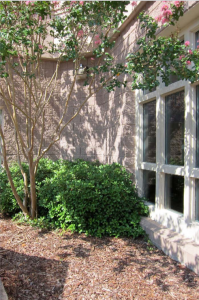
Figure 2. Vegetation touching the structure can provide a bridge over treated areas (Photo: Patty Alder, NCSU).
Many ants are attracted to the sweet plant secretions and fruits/berries of ornamental trees and shrubs. Ants also feed on “honeydew” – a sugary material secreted by aphids and other insects often found on ornamentals. Trim back any tree branches or shrubs that are touching the house so that ants cannot use them to get around pesticide treated areas and enter the home (Figure 2). Controlling honeydew-producing insects on ornamental trees and shrubs will help reduce ant food sources.
Insecticidal Control. Simply spraying foraging ants may bring temporary relief but most often it fails to provide long-term, effective control. The most effective ant control is accomplished by locating and destroying the nest(s). Sometimes the nest can be found by following the foraging workers back to the nest site. Once the nest is found you can spray or drench it with a spray or granular insecticide. Or you may treat the nest using a bait; just remember baits are slower acting.
While finding and destroying the nest is the most effective control strategy for ants, finding the nest is not always possible. Many pest ants we deal with do not make large, discreet nests (e.g., Argentine and odorous house ants). And these ants often have multiple nests spread out over the landscape. Therefore, finding and treating each nest may not be possible. In those cases, you can apply an insecticide outdoors to help reduce ant populations and possibly keep ants from invading the home. Spray any known or suspected ant entryways: gaps around doors and window frames, cracks in bricks and foundations, around crawl space doors, foundation vents and utility openings, and under siding. In addition, you may apply a protective barrier or perimeter around the home.
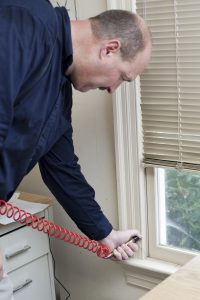
Figure 3. Limit indoor spraying to crack-and-crevice and void treatments where possible (Photo: Patty Alder, NCSU).
You may also need to spray indoors for ants. If that is the case, stick with crack-and-crevice applications and spot treatments, wherever possible (Figure 3). Try to limit your indoor spraying to known or suspect areas ants are using to access the building.
When choosing an insecticide, you have the option to apply a repellent or non-repellent product. Understanding the difference between repellent and non-repellent insecticides will help you determine which formulation is best suited for the situation.
Fast acting pyrethroid insecticides, like Demand® CS, are considered repellent products because they create a barrier and act quickly to prevent ants from maintaining a pheromone trail. The resulting distraction from their trail gives the appearance that they have been repelled, even if a product formulation limits repellency.
Slower acting insecticides, like Termidor®, are considered non-repellent products and take longer to knock down an insect. Insects cross over surfaces treated with these insecticides and return to the nest before they are affected, thus maintaining a trail and encouraging more ants to come in contact with the same treatment. In addition, foragers that have contacted the chemical may “transfer” some of the chemical to other colony members through grooming and feeding activities.
Both formulations have pros and cons. Fast-acting repellent insecticides are excellent for creating chemical barriers around structures, but a thorough application is crucial. The chemical must penetrate heavy vegetation, ground cover or mulch and reach the ground so that foraging ants come in contact with the treatment. In such cases, the use of a granular insecticide like Demand® G may help move the active ingredient through the vegetation or mulch where it can create a complete barrier to insect movement. Just remember that granular formulations need to be watered in.
The slower action of non-repellent insecticides is great because it does allow foragers to get some of the chemical back to the nest where other ants can be exposed to it. On the other hand, because ants will move more readily through the insecticide, your customer may likely continue to see ants indoors (at least for some time).
Whether you use a repellent or non-repellent insecticide will depend on each unique situation. What ant species is/are present? How tolerant is your customer? How bad is the infestation? Etc., etc. In addition, communicating with and educating your customer on your decision will be key, regardless of what product you choose.
The other obvious treatment option for ants is baiting. Bait may be applied indoors and outdoors. When baiting indoors, your customer should expect to see ants at or near the bait. Again, this is where communication and education are key. If you are dealing with a customer that has low tolerance, try to place the bait in out-of-sight areas. Or, you may choose to bait outdoors only.
Before you spend a lot of time (and money) on a complete bait application, make sure the ants accept the bait. Once you find an acceptable bait, place it at or near areas you are seeing ant activity. And be sure baits are placed away from areas you have applied a spray or granular insecticide.
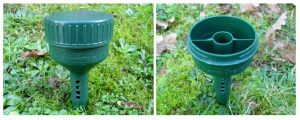
Figure 4. Outdoor bait stations are an excellent choice for high populations of ant species that prefer liquid, sugary foods (Photo: www.spmglobal.com).
For ant species that tend to present in high numbers, such as Argentine and odorous house ants, you may consider placing a liquid, sugar-based bait outdoors in plastic bait stations (Figure 4). Many times baits are not effective simply because a sufficient amount is not put out to account for the large infestation. Carpenter ants and red imported fire ants seem to accept granular baits quite well. But again, because food preferences can change for ants, depending on the season and other food availability, it’s always a good idea to make sure the ants are accepting what you are offering before you apply it everywhere.
In summary, treating for ants will be most successful when you first determine what ant species is present. Client cooperation on recommendations for best sanitation, exclusion, and habitat alteration practices is necessary as well. And finally, choosing the correct chemistry and insecticide formulation(s) is key – and that will be decided by each unique situation.
Featured Creature: Horntails and Wood Wasps

The names “wood wasp” and “horntail” describe several kinds of wood-boring insects in the Order Hymenoptera, Family Siricidae. Of greatest concern are the large, non-stinging wasps that are attracted to and complete their life cycles in newly dead or dying conifer trees. If timber is salvaged from these trees, adult wasps may emerge from infested lumber in recently completed structures (see Figure 1).
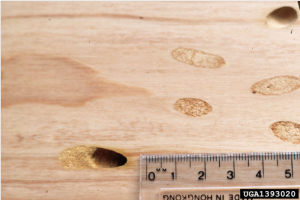
Figure 1. Wood sawn from a tree damaged by Sirex noctilio (Photo by Dennis Haugen, Bugwood.org).
There are several species of horntails, all looking very similar. They are large wasps, generally 1 inch or longer. They have a wasplike appearance but lack a noticeable constriction in the abdomen, as seen with many wasps. They are often black or metallic dark blue or combinations of black, red, and yellow.
The male and female have a similar body shape, except the female is larger and has a very prominent ovipositor. The female can use her ovipositor only for egg laying; she can’t use it to sting in defense.
The female drills her ovipositor nearly 3/4” into the wood of a weakened or dying tree and lays 1 to 7 eggs.
She may lay up to 200 eggs in her lifetime. Eggs hatch in 3 to 4 weeks, and larvae tunnel into the wood parallel with the grain. Larval feeding continues through 5 or more immature stages, which take at least a year and as many as 5 years in cooler climates to complete. The tunnel, or gallery, usually measures 10 to 12 inches long at completion.
Pupation takes place at the end of the gallery. After 5 or 6 weeks as a pupa, the adult emerges by chewing through about 3/4” of wood, leaving a round exit hole 1/4” – 1/2” diameter.
Although they can be extremely annoying, and can look intimidating to many people, horntails are not harmful to humans or structures. They only attack trees and won’t bore into wood in buildings or furniture, and therefore, will not re-infest structures. Fortunately, the damage is more cosmetic and does not cause any real structural damage. The only real management strategy would be to repair or replace any cosmetic damage.

